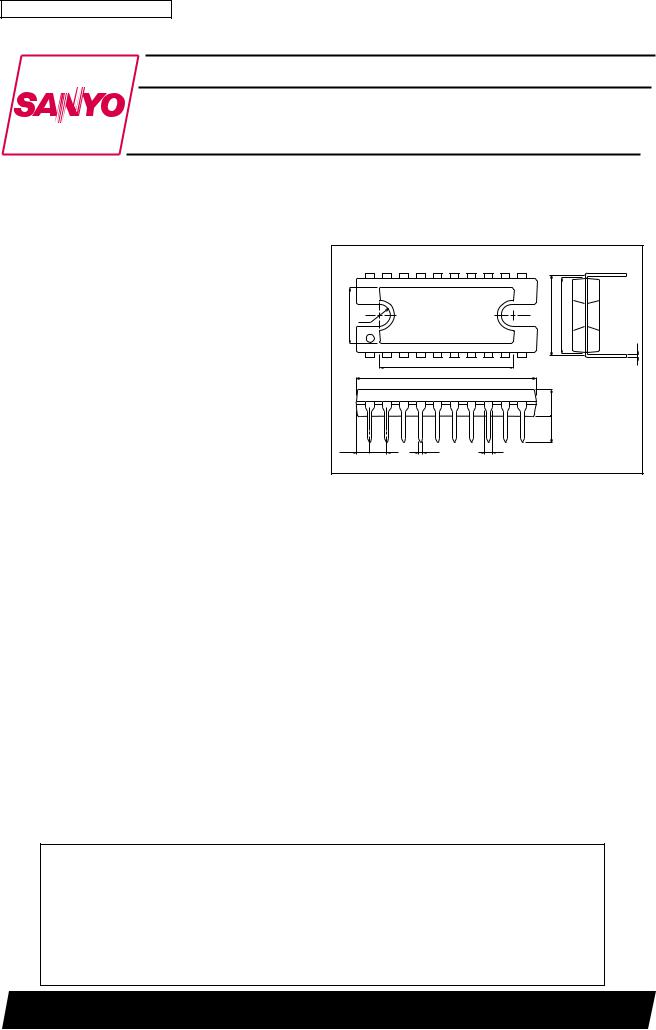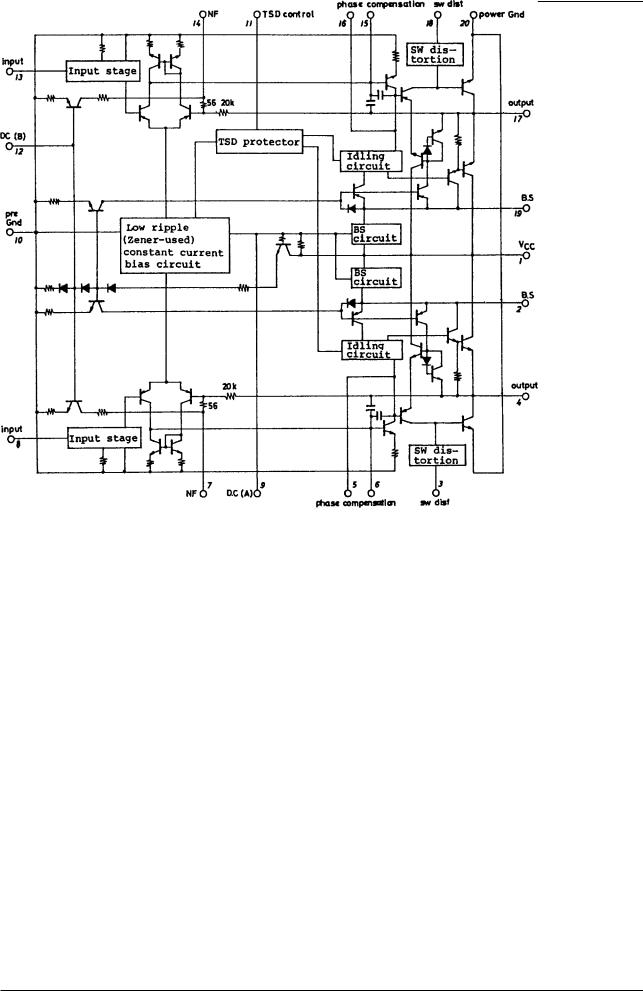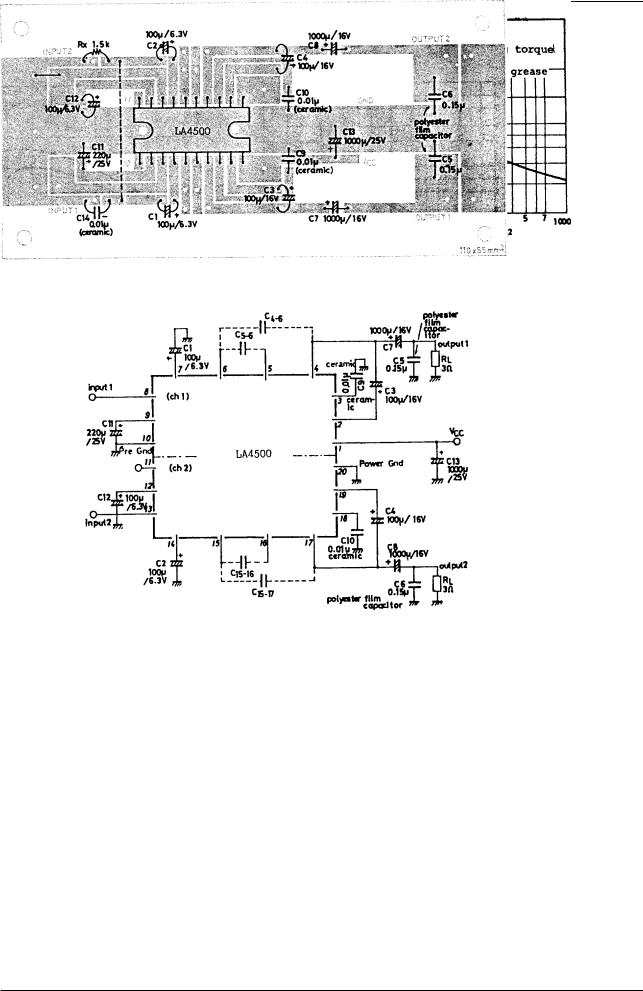SANYO LA4500 Datasheet

Ordering number:ENN1164C
Monolithic Linear IC
LA4500
5.3W 2-Channel AF Power Amplifier
Features
•Low idling current (20mA/2 channels) enabling prolonged battery life.
•Less dependence of idling current on VCC.
•High power (5.3W typ. ×2).
•High ripple rejection (60dB at steady state).
Since filters are arranged in 3 stages (including 1 stage inside the IC) to attain satisfactory ripple rejection at transient state, ripple occuring at the time of motor start can be prevented from mixing in.
•Low pop noise at the time of power supply ON/OFF and good starting balance between both channels (0.6s.) due to built-in pop noise limiter.
•Pins provided for compensating high frequency responce.
•Low residual noise (0.4mV).
•Wide supply voltage range (6 to 24V) fascilitating design of transformer power supply.
•Built-in thermal shutdown circuit,
•Designed so that inverse insertion or short between adjacent pins causes no destruction.
•Channel-to channel mirror image pin assignment and provision of Pre GND, Power GND pins enabling stable operation and fascilitating artwork of printed circuit board.
•Minimum number of external parts required (9pcs. min., 12pcs. typ.).
•Audio muting capability (for automatic music selection, electronic tuner).
Package Dimensions
unit:mm |
|
|
|
|
|
3037A-DIP20H |
|
|
|
|
|
|
|
|
|
[LA4500] |
|
|
20 |
|
|
11 |
|
8.4 |
R1.7 |
|
|
12.7 |
11.2 |
|
|
|
|
|
0.4 |
|
1 |
|
20.0 |
10 |
|
|
|
|
|
|
|
|
|
|
27.0 |
|
|
|
|
|
|
4.0 |
|
|
|
|
|
4.0 |
|
2.07 |
2.54 |
0.6 |
|
1.3 |
|
|
|
|
|
SANYO : DIP20H |
|
Specifications
Absolute Maximum Ratings at Ta = 25˚C
Parameter |
Symbol |
Conditions |
Ratings |
Unit |
|
|
|
|
|
Maximum supply voltage |
VCC max |
|
24 |
V |
Maximum output current |
IO peak |
1 channel |
2.5 |
A |
Allowable power dissipation |
Pd max |
With infinite heat sink |
15 |
W |
|
|
|
|
|
Operating temperature |
Topr |
|
–20 to +75 |
˚C |
|
|
|
|
|
Storage temperature |
Tstg |
|
–40 to +150 |
˚C |
|
|
|
|
|
 Any and all SANYO products described or contained herein do not have specifications that can handle applications that require extremely high levels of reliability, such as life-support systems, aircraft’s control systems, or other applications whose failure can be reasonably expected to result in serious physical and/or material damage. Consult with your SANYO representative nearest you before using any SANYO products described or contained herein in such applications.
Any and all SANYO products described or contained herein do not have specifications that can handle applications that require extremely high levels of reliability, such as life-support systems, aircraft’s control systems, or other applications whose failure can be reasonably expected to result in serious physical and/or material damage. Consult with your SANYO representative nearest you before using any SANYO products described or contained herein in such applications.
 SANYO assumes no responsibility for equipment failures that result from using products at values that exceed, even momentarily, rated values (such as maximum ratings, operating condition ranges,or other parameters) listed in products specifications of any and all SANYO products described or contained herein.
SANYO assumes no responsibility for equipment failures that result from using products at values that exceed, even momentarily, rated values (such as maximum ratings, operating condition ranges,or other parameters) listed in products specifications of any and all SANYO products described or contained herein.
SANYO Electric Co.,Ltd. Semiconductor Company
TOKYO OFFICE Tokyo Bldg., 1-10, 1 Chome, Ueno, Taito-ku, TOKYO, 110-8534 JAPAN
21500TN (KT)/N2996RM/9036KI/8064KI No.1164–1/12

LA4500
Recommended Operating Conditions at Ta = 25˚C
Parameter |
Symbol |
Conditions |
Ratings |
Unit |
|
|
|
|
|
Supply voltage |
VCC |
|
12 |
V |
Load resistance |
RL |
Stereo |
3 |
Ω |
Operating Characteristics at Ta = 25˚C, VCC=12V, RL=3Ω (stereo), f=1kHz, Rg=600Ω, See specified test circuit.
Parameter |
Symbol |
Conditions |
|
Ratings |
|
Unit |
|
|
|
||||
|
|
|
min |
typ |
max |
|
|
|
|
|
|
|
|
Quiescent current |
ICCO |
Stereo |
10 |
20 |
30 |
mA |
Voltage gain |
VG |
|
48 |
50 |
52 |
dB |
|
|
|
|
|
|
|
Voltage gain difference |
VG |
Channel 1, 2 |
|
|
±1 |
dB |
|
|
|
|
|
|
|
Output power |
PO |
THD=10% |
4.5 |
5.3 |
|
W |
Total harmonic distortion |
THD |
VO=2V |
|
0.3 |
1.5 |
% |
Input resistance |
ri |
|
|
30 |
|
kΩ |
Output noise voltage |
VNO1 |
Rg=0, f=20Hz to 20kHz, Band-pass filter |
|
0.4 |
1.0 |
mV |
VNO2 |
Rg=10kΩ, f=20Hz to 20kHz, Band-pass filter |
|
0.6 |
2.0 |
mV |
|
|
|
|||||
Ripple rejection |
Rr |
Rg=0, fR=100Hz, VR=0dBm |
50 |
60 |
|
dB |
Channel separation |
ch sep |
Rg=10kΩ, Vo=0dBm |
45 |
55 |
|
dB |
|
|
|
|
|
|
|
Equivalent Circuit Block Diagram
No.1164–2/12

LA4500
Sample Application Circuit 1
No.1164–3/12

LA4500
Description of External Parts
C1 (C1) Feedback capacitors
Related to low roll-off frequency fL for –3dB (100µF, fL=60Hz).
A capacitance value of 47µF to 100µF is recommended. Increasing the capacitance value makes the starting time (ts) later. Decreasing the capacitance value makes the starting time (ts) earlier.
C3 (C4) Bootstrap capacitors
Decreasing the capacitance value lowers output at low frequencies. A capacitance value of 47µF to 100µF is recommended.
C5 (C6) Oscillation blocking capacitors
Polyester film capacitor, being excellent in temperature characteristic, frequency characteristics, is recommended.
C7 (C8) Output capacitors
Related to low roll-off frequency and output at low frequencies. BTL applications normally require output capacitors.
C9 (C10) Switching distortion compensating capacitors
Compensates switching distortion which occurs at a high frequency of 10kHz. Ceramic capacitor of 0.01µF is recommended. If no problem arises in terms of radio-casette recorder design or tone, it is unnecessary to use these capacitors.
C11 Filter capacitor (A)
Ripple filter circuit provided in power supply line. A capacitance value of 220µF is recommended. Ripple rejection SVRR starts to be saturated at 47µF. The starting time and pop noise generated at the time of power supply ON must be considered when fixing the capacitance value. A capacitance value of 100µF to 220µF is usable.
C12 Filter capacitor (B)
Ripple filter circuit provided in bias circuit. A capacitance value of 100µF is recommended. 3V suffices the breakdown voltage of this capacitor. This capacitor is for ripple rejection at transient state and rejects noise “buzz” generated when the above-mentioned filter circuit provided in power supply line is saturated due to large ripple and supply voltage drop induced at the time of start of the motor connected to power supply line. If the motor is satisfactory in performance and the power supply regulation including ripple is 500mVrms or less, it is unnecessary to use this capacitor. If noise “buzz” is not offensive to the ear, it is unnecessary to use this capacitor. In this case, other basic performances are not affected adversely.
Feaures of IC Contents and Functions of Other Pins
(a)Since the input circuit uses PNP transistors and the bias voltage is set nearly equal to 0, no input coupling capacitor is required, thereby enabling direct coupling. However, if slider contact noise of the variable resistor presents any problem, connect a capacitor in series with input.
(b)Various ideas embodied in the idling circuit enable reduced ICCO and prolonged battery life. Since the nonoperating level of the idling circuit is made equal to that of the amplifier, crossover distortion does not worsen at
the time of reduced voltage.
(c)The open loop voltage gain is lowered and the negative feedback amount is made small to assure stable operation. Radiation to the radio-frequency stage is made less by soft clipping.
(d)Capacitors for oscillation compensation are contained as a means of reducing the number of external parts. 10pF×2 and 2pF×2 are used. Hig roll-off frequency fH (–3dB point) depends on these capacitance values. (fH=28kHz)
(e)A thermal shutdown (THD) circuit is contained to prevent the IC from being destroyed by abromal heat generation attributable to insufficient heat dissipation. Pin (11) is used as THD control pin. Biasing pin (11) externally makes the operating temperature lower ; and connecting a resister across pin (11) and (10) makes the operating temperature higher. If pin (11) is connected to GND, the thermal shutdown circuit stops operating.
(f)The pin assignment is carefully considered so that no destruction takes place even if power supply is applied at a state where adjacent pins are shorted by solder bridge, etc. Even 180°C-rotated insertion causes no destruction.
(g)Collector pins (5), (16) and base pins (6), (15) for predrive can be conveniently used in applications. For oscillation compensation occuring when operated at a lowered gain, connect a capacitor across the pins (4) and (6) and a capacitor across pins (15) and (16). For fH compensation occuring when operated at a lowered gain, connect a capacitor across pins (4) and (6) and a capacitor across pins (17) and (15). Further soft clippling and prevention
of waveform distortion at high frequencies are attained by connecting a series circuit of diode (DS442) and resistor (10kΩ) across pin (6) and GND and the same across pin (15) and GND.
Continued on next page.
No.1164–4/12
